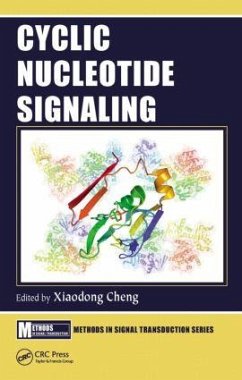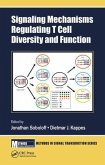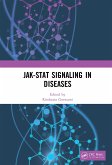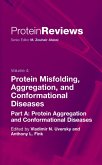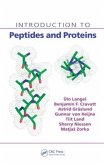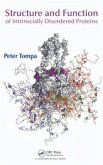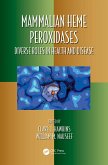Cyclic Nucleotide Signaling
Herausgeber: Cheng, Xiaodong
Schade – dieser Artikel ist leider ausverkauft. Sobald wir wissen, ob und wann der Artikel wieder verfügbar ist, informieren wir Sie an dieser Stelle.
Cyclic Nucleotide Signaling
Herausgeber: Cheng, Xiaodong
- Gebundenes Buch
- Merkliste
- Auf die Merkliste
- Bewerten Bewerten
- Teilen
- Produkt teilen
- Produkterinnerung
- Produkterinnerung
Showcasing the recent progresses of the field, Cyclic Nucleotide Signaling covers the major tools and methodologies used in various areas of research.
Andere Kunden interessierten sich auch für
![Signaling Mechanisms Regulating T Cell Diversity and Function Signaling Mechanisms Regulating T Cell Diversity and Function]() Signaling Mechanisms Regulating T Cell Diversity and Function185,99 €
Signaling Mechanisms Regulating T Cell Diversity and Function185,99 €![Jak-Stat Signaling in Diseases Jak-Stat Signaling in Diseases]() Jak-Stat Signaling in Diseases176,99 €
Jak-Stat Signaling in Diseases176,99 €![Protein Misfolding, Aggregation and Conformational Diseases Protein Misfolding, Aggregation and Conformational Diseases]() Vladimir N. Uversky / Anthony L. Fink (eds.)Protein Misfolding, Aggregation and Conformational Diseases242,99 €
Vladimir N. Uversky / Anthony L. Fink (eds.)Protein Misfolding, Aggregation and Conformational Diseases242,99 €![Introduction to Peptides and Proteins Introduction to Peptides and Proteins]() Ulo LangelIntroduction to Peptides and Proteins253,99 €
Ulo LangelIntroduction to Peptides and Proteins253,99 €![Structure and Function of Intrinsically Disordered Proteins Structure and Function of Intrinsically Disordered Proteins]() Peter TompaStructure and Function of Intrinsically Disordered Proteins265,99 €
Peter TompaStructure and Function of Intrinsically Disordered Proteins265,99 €![Mammalian Heme Peroxidases Mammalian Heme Peroxidases]() Mammalian Heme Peroxidases177,99 €
Mammalian Heme Peroxidases177,99 €![Today's Curiosity is Tomorrow's Cure Today's Curiosity is Tomorrow's Cure]() Steve CaplanToday's Curiosity is Tomorrow's Cure68,99 €
Steve CaplanToday's Curiosity is Tomorrow's Cure68,99 €
Showcasing the recent progresses of the field, Cyclic Nucleotide Signaling covers the major tools and methodologies used in various areas of research.
Produktdetails
- Produktdetails
- Verlag: CRC Press
- Seitenzahl: 288
- Erscheinungstermin: 12. Mai 2015
- Englisch
- Abmessung: 231mm x 157mm x 23mm
- Gewicht: 544g
- ISBN-13: 9781482235562
- ISBN-10: 1482235560
- Artikelnr.: 41858119
- Herstellerkennzeichnung
- Libri GmbH
- Europaallee 1
- 36244 Bad Hersfeld
- gpsr@libri.de
- Verlag: CRC Press
- Seitenzahl: 288
- Erscheinungstermin: 12. Mai 2015
- Englisch
- Abmessung: 231mm x 157mm x 23mm
- Gewicht: 544g
- ISBN-13: 9781482235562
- ISBN-10: 1482235560
- Artikelnr.: 41858119
- Herstellerkennzeichnung
- Libri GmbH
- Europaallee 1
- 36244 Bad Hersfeld
- gpsr@libri.de
Cheng, Xiaodong
Compartmentalization of cyclic nucleotide signaling. Analysis of
EPAC-mediated cAMP functions in cell communication. Cyclic nucleotide
analogs as pharmacological tools for studying signaling pathways. Discovery
of small molecule EPAC specific modulators. Adenylyl cyclase and A
kinase-anchoring proteins in cardiovascular physiology and pathology.
Cyclic nucleotide recognition and selectivity. Real-time intracellular
imaging of cGMP. Dissecting cyclic nucleotide signalosomes by chemical
proteomics. Cyclic nucleotide analogs as chemical tools for interaction
analyses. cAMP signaling in pancreatic ß cells. Quantitative high
throughput cAMP assay for G-protein coupled receptors. Quantitative
proteomics analysis of the cAMP signaling pathway. Network analysis of
cyclic nucleotide signaling. Evolution and functional diversity of cyclic
nucleotide binding domains. X-ray crystallographic analysis of cyclic
nucleotide activated protein kinases. Dissect physiological functions of
PKA isoforms using genetically modified mouse models. Assessing cyclic
nucleotide binding domain allostery by NMR analysis. Fluorescence resonance
energy transfer (FRET) imaging of cyclic nucleotide in live cells.
Structural and functional analyses of exchange protein directly activated
by cAMP. Structural analysis of PKA: strategies for therapeutic
intervention. Monitoring cyclic nucleotide signaling using genetically
encoded fluorescent reporters.
EPAC-mediated cAMP functions in cell communication. Cyclic nucleotide
analogs as pharmacological tools for studying signaling pathways. Discovery
of small molecule EPAC specific modulators. Adenylyl cyclase and A
kinase-anchoring proteins in cardiovascular physiology and pathology.
Cyclic nucleotide recognition and selectivity. Real-time intracellular
imaging of cGMP. Dissecting cyclic nucleotide signalosomes by chemical
proteomics. Cyclic nucleotide analogs as chemical tools for interaction
analyses. cAMP signaling in pancreatic ß cells. Quantitative high
throughput cAMP assay for G-protein coupled receptors. Quantitative
proteomics analysis of the cAMP signaling pathway. Network analysis of
cyclic nucleotide signaling. Evolution and functional diversity of cyclic
nucleotide binding domains. X-ray crystallographic analysis of cyclic
nucleotide activated protein kinases. Dissect physiological functions of
PKA isoforms using genetically modified mouse models. Assessing cyclic
nucleotide binding domain allostery by NMR analysis. Fluorescence resonance
energy transfer (FRET) imaging of cyclic nucleotide in live cells.
Structural and functional analyses of exchange protein directly activated
by cAMP. Structural analysis of PKA: strategies for therapeutic
intervention. Monitoring cyclic nucleotide signaling using genetically
encoded fluorescent reporters.
Compartmentalization of cyclic nucleotide signaling. Analysis of
EPAC-mediated cAMP functions in cell communication. Cyclic nucleotide
analogs as pharmacological tools for studying signaling pathways. Discovery
of small molecule EPAC specific modulators. Adenylyl cyclase and A
kinase-anchoring proteins in cardiovascular physiology and pathology.
Cyclic nucleotide recognition and selectivity. Real-time intracellular
imaging of cGMP. Dissecting cyclic nucleotide signalosomes by chemical
proteomics. Cyclic nucleotide analogs as chemical tools for interaction
analyses. cAMP signaling in pancreatic ß cells. Quantitative high
throughput cAMP assay for G-protein coupled receptors. Quantitative
proteomics analysis of the cAMP signaling pathway. Network analysis of
cyclic nucleotide signaling. Evolution and functional diversity of cyclic
nucleotide binding domains. X-ray crystallographic analysis of cyclic
nucleotide activated protein kinases. Dissect physiological functions of
PKA isoforms using genetically modified mouse models. Assessing cyclic
nucleotide binding domain allostery by NMR analysis. Fluorescence resonance
energy transfer (FRET) imaging of cyclic nucleotide in live cells.
Structural and functional analyses of exchange protein directly activated
by cAMP. Structural analysis of PKA: strategies for therapeutic
intervention. Monitoring cyclic nucleotide signaling using genetically
encoded fluorescent reporters.
EPAC-mediated cAMP functions in cell communication. Cyclic nucleotide
analogs as pharmacological tools for studying signaling pathways. Discovery
of small molecule EPAC specific modulators. Adenylyl cyclase and A
kinase-anchoring proteins in cardiovascular physiology and pathology.
Cyclic nucleotide recognition and selectivity. Real-time intracellular
imaging of cGMP. Dissecting cyclic nucleotide signalosomes by chemical
proteomics. Cyclic nucleotide analogs as chemical tools for interaction
analyses. cAMP signaling in pancreatic ß cells. Quantitative high
throughput cAMP assay for G-protein coupled receptors. Quantitative
proteomics analysis of the cAMP signaling pathway. Network analysis of
cyclic nucleotide signaling. Evolution and functional diversity of cyclic
nucleotide binding domains. X-ray crystallographic analysis of cyclic
nucleotide activated protein kinases. Dissect physiological functions of
PKA isoforms using genetically modified mouse models. Assessing cyclic
nucleotide binding domain allostery by NMR analysis. Fluorescence resonance
energy transfer (FRET) imaging of cyclic nucleotide in live cells.
Structural and functional analyses of exchange protein directly activated
by cAMP. Structural analysis of PKA: strategies for therapeutic
intervention. Monitoring cyclic nucleotide signaling using genetically
encoded fluorescent reporters.

